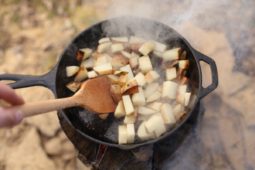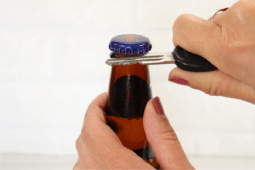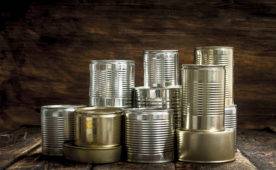David’s DIY Kitchen Upgrade: How He Did It (Step by Step)

They say the kitchen is the heart and the soul of any house, and mine didn't really have much of either. Made from builder-grade materials and outfitted with the most basic appliances, it was time to upgrade my kitchen and add a lot more personality to it. Follow along as I walk you through the transformation.
With an ambitious timeframe and plenty of work to do, the best place to start was a shopping trip to Lowe's for what we needed. It took about two hours to collect materials from all over the store, but in the end we had a huge cart full of everything from tiles and adhesive to paints and a skylight kit. After organizing everything by project in the garage, we got to work.
![credit: David [manmadediy.com] Remodel Supplies](https://s3.amazonaws.com/manmadediy-uploads-production/photos/25674/DSC_0511_large.jpg?1431987425)
Here’s the schedule we created to help the project along (we scheduled about 4-6 hours of work per day):
Day 1 – Remove and organize cabinet doors, sand down and prepare walls for backsplash, prime cabinets (coats 1 and 2).
Day 2 – Prepare cabinet doors (sand, fill holes, first primer coat), make sure all cabinets are level (they weren’t), take outlet covers off and set up backsplash materials.
Day 3 – Prime cabinet doors (second primer coat), install backsplash tiles on one wall, Paint cabinets (first paint coat).
Day 4 – Paint cabinet doors (second paint coat), install backsplash tiles on second wall (minus the detail pieces).
Day 5 – Paint cabinet doors (third paint coat), finish up backsplash tile and grout, and install skylight.
Day 6 – Install doors and handles, install molding and trim, and paint walls.
Day 7 – Install kitchen faucet and finish touch-up work. Lowe’s installers put in our new Frigidaire Professional Series appliances!
Keep in mind that the entire project took place over the course of about two weeks – with a few days in between and most of the work occurring after a full day of real life. Needless to say, we’re excited to get past this hectic period and start enjoying the new space. But first, a few words about each portion of the project and how it went:![credit: David [manmadediy.com] Tile Work](https://s3.amazonaws.com/manmadediy-uploads-production/photos/25675/DSC_0035_large.jpg?1431987528)
Tile Backsplash
Time: About 3 hours.
Cost: $275
I started this project by reading up on tile installation on Lowe’s website. I’ve done backsplash work before, so adding tile to the walls was not a new experience for me, but it was complex enough that I’m glad I took some time to go over the details.
- The key to getting tiles to stick is good surface preparation and a solid layer of adhesive. When preparing the surface, the walls need to be clean and free of grease, and fully flat. If there are a few areas that need work, flatten them out by sanding down or filling in with the proper skim-coat/patch material. This is the time to unscrew the outlets and extend them if necessary to match up to the new tile thickness (be sure to turn off the circuit prior to getting near electrical wires, or get a qualified electrician if you’re not sure what you’re doing).
![credit: David [manmadediy.com] Adding Detail Tiles](https://s3.amazonaws.com/manmadediy-uploads-production/photos/25676/DSC_0103_large.jpg?1431987632)
- Thanks to the magic of mesh-backed 12×12 tile sheets, the job goes pretty fast in the open areas. But when it comes to edges, corners, and electrical boxes, the process slows down to a crawl. I like to start at one end and fill up all the open spaces first, while just broadly removing the detail pieces with the intent to come back and spend time on them all at once.
![credit: David [manmadediy.com] Adding Grout](https://s3.amazonaws.com/manmadediy-uploads-production/photos/25677/DSC_0105_large.jpg?1431987772)
- For most of the work, I used a simple tile cutter ($30), which is great for single cuts, but it doesn’t work for angles or complex pieces. A set of nippers and an angle grinder with a diamond bit worked well enough for all the other cuts (especially since most were under outlet covers). While a wet saw does provide a cleaner (and more precise) cut in tiles, the cost ($80-$120) doesn’t justify the relatively sparse use of the tool in my shop. Renting one is a great option if you have enough tiling to justify that expense.
![credit: David [manmadediy.com] Marking the Skylight Outline](https://s3.amazonaws.com/manmadediy-uploads-production/photos/25678/DSC_0106_large.jpg?1431987856)
Solar Tube Skylight
Time: Less than 1 hour.
Cost: $300
This was the first solar tube-style light I’ve installed, and I have to say it was much easier than I expected. A few simple cuts and less than a handful of screws was all it took to get a huge amount of natural light into the kitchen. It was actually hard to install the light cover onto the diffuser because of the incredible amount of light streaming in. Sunglasses help.
- The first step was tracing an outline on the ceiling with the provided template (be sure it’s centered between joists before slicing into the drywall). Cutting the outline with a drywall saw took about 3 minutes and left an easy access hole to the bottom of the roof sheathing. Reaching up through the hole I was able to drill a simple pilot hole up through the shingles on the roof. Then I simply found my pilot hole from above and traced my hole outline on the shingles.
![credit: David [manmadediy.com] Tube Skylight](https://s3.amazonaws.com/manmadediy-uploads-production/photos/25679/DSC_0119_large.jpg?1431987960)
- For the next step I used an oscillating saw to cut the hole right through the shingles, felt paper, and plywood for a matching hole.
- Lastly, adding the roof flashing took about 10 minutes including sealant. Inserting the tube with final seals rounded out the entire project at 45 total minutes from first cut to stepping back in solar-blinded admiration.
![credit: David [manmadediy.com] The hole for skylight](https://s3.amazonaws.com/manmadediy-uploads-production/photos/25680/DSC_0113_large.jpg?1431988060)
This project was easier than some installations might be, due to the shingled roof, and easy access to the roof and attic. But overall the skill level needed was well within DIY territory and the results are just … brilliant.![credit: David [manmadediy.com] HGTV Showcase Paint](https://s3.amazonaws.com/manmadediy-uploads-production/photos/25681/20150505_105930_large.jpg?1431988234)
Painted Cabinets and Crown Molding
Time: 30 hours
Cost: $550
By far the most difficult portion of the whole project was painting the cabinets. Thankfully, the cabinets also added the most to the overall look of the space. The fresh coat of paint brought in both depth and color, while also simplifying the room. For a really in depth tutorial, check out this article on how to paint kitchen cabinets over at Curbly.
Everyone knows (or should know) that prep is the most important part of painting. And cabinets are really tricky to prep (lots of grooves, angles, and corners). Also, cabinets require multiple coats of paint for a durable finish that will stand up to heavy daily use.
Here’s what I did:![credit: David [manmadediy.com] Prepping the Doors](https://s3.amazonaws.com/manmadediy-uploads-production/photos/25683/DSC_0527_large.jpg?1431988462)
- Step 1: all doors were wiped down with a grease remover like TSP (Trisodium Phosphate), then lightly sanded to open up the grain. I filled all door handle holes and sanded them smooth.
![credit: David [manmadediy.com] Priming The Cabinets](https://s3.amazonaws.com/manmadediy-uploads-production/photos/25682/DSC_0542_large.jpg?1431988294)
- Step 2: Primer. We used Valspar Bonding Primer as the first and second coat for all doors and cabinet frames to make sure that the paint had a good surface to bond to, and to make sure any stain or grease left on the doors would never bleed through.
![credit: David [manmadediy.com] Painted Cabinets](https://s3.amazonaws.com/manmadediy-uploads-production/photos/25684/20150502_223238_large.jpg?1431988532)
- Step 3: Three coats of paint using HGTV Home by Sherwin Williams paint and primer (Snowbound SW 7004 & Web Gray SW 7075).
After painting the first few doors with a foam brush, I realized that there were too many to realistically get done within our schedule. So I busted out my Graco Truecoat sprayer (similar to this model) to speed up the process and give me a much smoother finish.![credit: David [manmadediy.com] Graco Paint Sprayer](https://s3.amazonaws.com/manmadediy-uploads-production/photos/25685/20150501_211224_large.jpg?1431988579)
I would have started with this method, but the gun is old and well-used so it’s a bit feisty and needs frequent cleaning or it gets clogged and starts to spit (ruining a fresh coat of paint instantly). I also had to take the time to set up a paint booth of plastic drops nailed to the ceiling and taped seams to a drop on the floor to keep the overspray in and the dust/bugs out. Even with the headaches and additional preparation, the sprayer substantially sped up the process and I was able to make solid time applying coats.
If you have a big paint project, I strongly recommend checking out paint sprayer rentals. You can get one for around $50/day, and it’s totally worth it if you know how to use it (and they’re not terribly hard to use).![credit: David [manmadediy.com] Drilling Hardware Holes](https://s3.amazonaws.com/manmadediy-uploads-production/photos/25686/DSC_0018_large.jpg?1431988645)
After all doors and cabinets were painted, I drilled new holes and installed the new allen + roth handles we picked out. I used a shop-made jig for this to make sure all handles were located in the same spots on the doors. While this worked, by the last few doors the jig holes were worn out and the handles were a bit out of square.![credit: David [manmadediy.com] Door Handles](https://s3.amazonaws.com/manmadediy-uploads-production/photos/25687/DSC_0019_large.jpg?1431988739)
Re-installing the doors was easy thanks to proper numbering when we removed them. Write a number on the hinge, and the corresponding number on the door under where the hinge installs, then put a small sticker or piece of tape over the number while painting. Since the hinge covers the small unpainted location, the number is easy to match back up and the doors go right back where they came from.![credit: David [manmadediy.com] Installing Trim](https://s3.amazonaws.com/manmadediy-uploads-production/photos/25690/DSC_0096_large.jpg?1431989010)
The final touch was installing trim and molding to upgrade the look of our builder-grade appliances. Here’s a great tutorial from Lowe’s on how to install molding.
- The first trim was installed at the bottom of the cabinet. I made a simple double-bead trim piece from clear pine, but store-bought styles are readily available as well.
- The top molding was a short crown that I cut using this great jig from Benchdog. With a few cuts and a bit of backing trim, the crown went on fast and dramatically improved the look of the space. This portion of the project was fast and simple with only a few tools needed.
![credit: David [manmadediy.com] Crown Molding](https://s3.amazonaws.com/manmadediy-uploads-production/photos/25691/DSC_0138_large.jpg?1431989053)
We finished off this long portion of the project by painting the walls to match the cabinets and backsplash. The same color we used on the cabinet (Snowbound SW 7004) brightened up the room and brought the whole space cleanly together. It’s amazing how much a coat of paint changes the feel of the space.
![credit: Lowe's [https://www.lowes.com/projects/kitchen-and-dining/how-to-install-a-kitchen-faucet/project] Lowe's Faucet Install](https://s3.amazonaws.com/manmadediy-uploads-production/photos/25693/install-a-kitchen-faucet-removeaerator_large.jpg?1432006750)
Kitchen Faucet
Time: 1 hour
Cost: $300
The new pull-down faucet was the final project on my list, and thankfully it didn’t put up much of a fight. With a simple faucet wrench, some sealant tape and plumber's putty the installation was a fast switch and really added a nice pop to the kitchen, especially when doing dishes at the sink. Here’s a great tutorial from Lowe’s on how to replace a faucet, we'll have pictures of the shiny new faucet in the reveal post!![credit: David [manmadediy.com] Tile Backsplash](https://s3.amazonaws.com/manmadediy-uploads-production/photos/25692/DSC_0154_large.jpg?1431989287)
I can’t wait to get some great meals cooked in the new kitchen. There are a few original recipes centered around our cast iron pan that I’ve been saving for a special occasion and the first few meals on shiny professional appliances seems like the perfect opportunity. Gone are the days of uneven heating, and haphazard roasting controls! And, we’re finally past playing food Tetris to get the grocery run into the refrigerator. Since we spend so much time as a family gathered around meals, it’s amazing how a kitchen update makes the entire house feel brand new again. Now the next (and most important) step is to make some great food and spend some quality time sharing it with friends.
I’ll be back next week with the full reveal, and I’ll also be sharing some original recipes my wife and I came up with, just to give you a sense for how functional the kitchen has become. Stay tuned!
This post is sponsored by Frigidaire Professional, but all opinions are mine alone. Thanks for supporting the brands that support ManMade.









